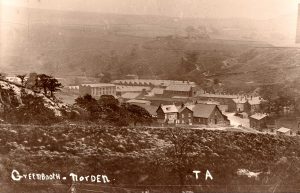Probably few other villages in England have such an impressive testimony to their existence as Greenbooth. For this little community was sacrificed so that a massive £2 million reservoir could be built. Inevitably the submergence of a village and disappearence of a community – even a dying one like Greenbooth – caught the public imagination far more than the building of the reservoir itself. But by 1958, however, the village had become a memory and the task of collecting and storing 700,000,000 gallons of water began to take shape. Slowly the valley was transformed – high cliffs were exposed and trees were torn down – until in 1961 the reservoir was nearing completion. It was officially opened in August 1965 and was, after 12 years of planning and work, the most ambitious project ever undertaken by the Heywood and Middleton Water Board. A plaque is now the only sign that a little village once existed where the deep waters are now. It reads “This tablet commemorates the village of Greenbooth, the site of which is submeged beneath the waters of the reservoir.” Greenbooth Reservoir took over two years to build at a cost of £2,101,000. It was planned and built by the Heywood and Middleton Water Board. The dam itself is at the southern end of the Naden Valley and it is the lowest of four reservoirs built in the valley. The dam is 117 feet high and 1,000 feet long. Greenbooth Mill was owned by James Butterworth and the village in its entirety was almost certainly his creation. James Butterworth lived at Tenterhouse in Norden. His daughter married a Mr R. H. Hutchinson, and their two sons later managed the mill, until they went bankrupt in 1911. Following this collapse, people began to move away from the village to find work and it gradually declined. 1840s Weaving Mill specialising in woollen flannel. Coal came from East Knowl colliery. Also fulling & finishing by 1891. Went bankrupt in 1911 when owned by James Butterworth’s grandsons. Disused by 1923, buildings off map by 1938. Tweedales Farm was evacuated for serviceroad in construction of reservoir, though a different route was eventually taken for road*.
*Malcolm Jones, Norden & District Local History Society

